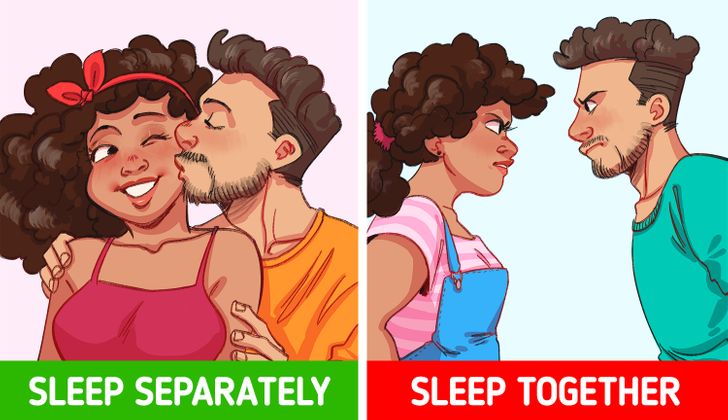According to a survey, only 14% of couples sleep in separate beds every night. And while many of us might believe in the saying “couples who sleep apart grow apart” there are studies that show the opposite is actually true.
We at Bright Side believe that there are no wrong or right sleep arrangements, because to some, sleeping in different beds can be as pleasing as for others sharing a bed with their partner.
A poor night’s sleep can turn lovers into fighters.

According to research, sharing a bed with a partner that has restless sleep behavior can deprive you of 49 minutes of sleep each night. And, when one partner doesn’t get a proper night’s sleep because of the other, it will most likely result in a conflict between them the next day.
Actually, the study even confirmed that couples who tend to have a poor night’s sleep have more severe and more frequent fights than those who wake up well-rested. People who get a good night’s sleep, on the other hand, are more likely to be in a good mood, have lower stress levels, and be more patient.
Resenting your partner because you can’t get a good night’s sleep can be destructive to the relationship.

Snoring, fidgeting, and bed or blanket hogging are just a few of many reasons why some couples choose to sleep in different beds or even in different bedrooms. Lying awake listening to your partner snoring while you beat yourself up to fall asleep can lead to a build-up of anger, tension, and resentment toward your partner.
According to Jennifer Adams, author of Sleeping Apart Not Falling Apart, sleeping in a separate bedroom can even help a relationship thrive because both partners are not sleep deprived.
Each partner can tailor their sleeping conditions to their heart’s content.

Tina Cooper, a licensed social worker, sleeps in different bedrooms with her partner because of their opposite sleeping habits. “I’m a night owl, he’s an early bird. I need soothing sounds to fall asleep, and he likes silence. He likes a hard mattress, and I like soft and full of pillows. And because I don’t like the early day’s sunlight, my boyfriend gave me the master bedroom which gets less light and he has the second largest room that gets the sunrise he loves.”

How you spend the nighttime in your shared bedroom with your partner can also influence your daytime functioning, marital satisfaction, and psychological and physical health. And when 2 people with different bedtime preferences and nighttime schedules end up together, changing themselves just to please their partner’s needs might harm their relationship in the long run.
Sleeping in different bedrooms with your partner means that the 2 of you will have a place just for yourselves where you can relax after an exhausting day. This way, both of you can satisfy your needs without tiptoeing around and worrying about whether your partner might wake up because you want to watch the latest episode of your show before bed.
Even if you don’t remember waking up, disturbed sleep can have a negative impact on your overall health.

During the night, our brain cycles through the stages of sleep several times: light sleep, deep sleep, and REM (Rapid eye movement sleep). But when you interrupt the cycle by waking up during the night, it means that your brain spends more time in the light sleep stage and misses out on REM. And without sufficient REM your emotional well-being and cognitive performance suffer.
Interrupted sleep can also have short and long-term health consequences, like hypertension, weight-related issues, mental health problems, reduced quality of life, and other health-related issues.
People on Reddit share why they decided to sleep separately with their partner.

- “Because a good night’s sleep is more romantic than sharing a bed. I snore and toss and turn. He gives off literal village levels of heat in his sleep and I can’t stand the heat. I read, he can’t stand light. We keep different hours to an extent. A million reasons. We get along so much better this way.” — crankyweasels
- “My partner and I have completely separate bedrooms. We ’sleepover’ occasionally in each other’s rooms. However, we both sleep exponentially better apart. He’s a night owl and I’m an early bird. He wants only one sheet on him, I want 10 lbs of blankets. In addition, having a separate room allows me to decorate it however I want, have my own personal space, and keep it to the level of cleanliness I prefer. People look at us sideways when I mention the separate rooms thing, but it’s been a game-changer.” — eriasana
- “Different sleep cycles due to different work schedules. We are still madly in love and we both agreed to this because it’s the best for both of us.” — AFishInATank
- “Early in our relationship, 90% of our fights occurred in the bedroom. I like to sleep in a cold room with the fan on and white noise like a box fan. I also like to go to sleep with the TV on. She likes to sleep in a warm, still, cave in complete silence and darkness. We started sleeping in separate rooms and all of a sudden 90% of our fights stopped. Also, because we were getting real sleep, other fights turned more into heated discussions.” — ttc8420
What are your sleeping arrangements with your partner? Do you believe sleeping in different beds can help a relationship thrive?
Poor Nurse Takes Care of 4 Elderly Sisters, Learns Their Will after They All Die

A poor nurse named Cassandra Myers lived a modest life while working at a local hospital. Although nurses generally earn decent wages in America, Cassandra found herself struggling financially because much of her income went toward paying off her late parents’ debts. She resided in her ancestral home, located in a peaceful neighborhood where her only nearby companions were four elderly siblings, all in their 80s.Cassandra often observed these elderly neighbors struggling with daily tasks like carrying groceries, cleaning their house, taking out the trash, and preparing meals. Realizing that they were in need of assistance, she offered her help whenever she returned from her hospital shifts. The four sisters appreciated her efforts and enjoyed her company immensely. One day, the eldest sister, Marie, expressed her gratitude, suggesting they pay Cassandra for her help.
However, Cassandra kindly refused, explaining that she was helping them out of care and not for financial gain. She made it a point to assist them daily, cooking their meals, washing dishes, organizing their medications, and even helping them get dressed. During one dinner together, Cassandra asked why the sisters hadn’t considered moving to a nursing home, where they could receive better care. Clara, one of the sisters, revealed that they had chosen to stay together in their own home rather than be separated in a nursing facility. They valued spending their remaining days surrounded by genuine love and care, which they felt might not be present in a nursing home environment.Understanding their perspective, Cassandra reassured them that she would always be there to help. The sisters were deeply touched by her kindness, with one of them remarking that she was the best neighbor anyone could ask for. Despite her exhaustion from work, Cassandra remained committed to visiting the siblings every day, sharing meals with them and tending to their needs. Sadly, as time passed, the sisters began to pass away one by one. Cassandra mourned each loss deeply and took it upon herself to organize their funerals. After the last sister passed away, Cassandra attended the funeral, where she met a lawyer named Abigail Smith. The lawyer expressed her gratitude to Cassandra for taking care of the sisters and informed her that there was something important she needed to discuss. The following day, Cassandra visited Abigail’s office, where she was handed a document. The lawyer explained that the sisters had children living in nearby states, but these children had not bothered to attend any of the funerals. Hurt by their children’s neglect, the sisters had decided to change their will, leaving everything to Cassandra instead.Cassandra was stunned by this revelation. She never expected to inherit the sisters’ estate, which included money, jewelry, and the house. Although she felt undeserving, Abigail reassured her that the sisters saw her as more of a daughter than their own children, making her the rightful heir. The inheritance was more than enough for Cassandra to pay off her parents’ debts, but the situation became complicated when the sisters’ children learned about the will. Initially, they wanted to contest it in court, but before they could proceed, Attorney Abigail sent them letters from their mothers. These letters, identical for each child, expressed the mothers’ love but also their deep disappointment over being neglected in their later years. The letters explained that the mothers had left their fortune to someone who had been there for them when their children were not. Upon receiving the letters, the children decided to withdraw their lawsuit. They realized how poorly they had treated their mothers and accepted that they did not deserve any part of the inheritance.Though Cassandra never met the sisters’ children, she noticed fresh flowers on the women’s graves each year on their death anniversaries. This small gesture brought her comfort, knowing that the sisters’ children were finally honoring their mothers, even if it was too late.



Leave a Reply